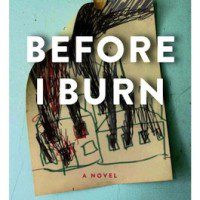When you tell the story of yourself, do you include the world events that were happening when you were born? The tragedies that took place in your hometown? For Norwegian writer Gaute Heivoll, identity extends far beyond family, and the result is an intriguing, often gripping novel/memoir/suspense, Before I Burn.
Heivoll expertly intertwines his personal history with that of Norway’s most notorious arsonist who set fire to ten buildings in May 1978, in the region of Finsland in Southern Norway, Heivoll’s home town.
In 2009, at age thirty, Heivoll returned to Finsland. He was digging through old photos when he found one of a small boy singing on stage. The boy was wearing a knitted jumper and his hair was recently cut. “It took me four, maybe five seconds. Then it clicked: ‘That’s me!’” writes Heivoll. Soon after, the fires make their reappearance in his mind, “as a kind of extension of this discovery.”
When the first fire was set May 1978, Heivoll was not yet two months old. “It has pursued me for thirty years although I have never known exactly what happened or indeed what it was all about. As a child I remember sitting in the back seat of a blue Datsun going to my grandparents’ at Heivollen, and on the way there we would pass the house where the pyromaniac lived. It was as though I could feel a waft of something outlandish and alluring as we drove past.” While in Finsland, Heivoll began researching the fires, reading old newspapers, watching TV broadcasts, and eventually interviewing people he’s known all his life who lived through the fires.

Using a braided structure, the novel moves back and forth, from the arsonist’s story to Heivoll’s. Early on, the identity of the arsonist is revealed: a young man from Finsland, the son of the fire chief, and therefore someone that no one suspects. The focus, then, is on how and why. As a young boy, Dag was smart and he excelled at school. “Later he became the best in his class at reading, and writing,” writes Heivoll. “He was so quiet, and rather shy. Good-natured to a fault. Not to mention how polite he was.” Before he was ten, Dag had seen a house burn down twice. He’d accompanied his father, the fire chief, who drove the fire engine. Quietly, smoothly, Heivoll enters Dag’s point of view. As the fire burned, young Dag heard a tone or a song, “A loud, high-pitched, signing tone that did not exist anywhere else but in the middle of a burning house.”
As the novel progresses, Dag speaks of the pyromaniac in the third person, “He’s a sick, sick man.” And when an old friend asks Dag what’s become of him, Dag responds, “No good has come of me.” Heivoll beautifully complicates rather than simplifies Dag’s motivation for setting the fires.
The other story line is about Heivoll. Like Dag, Heivoll was well-behaved and a good student with a promising future. He wanted to be like everyone else, but there was one problem—he often sat indoors reading. “They were books that slowly did things to me, that made me wish myself other places. Something inside me began to wander.” Like Dag, Heivoll had an intense relationship with his father. At age 18, Heivoll moved to Oslo to study law. He was going to be a lawyer, he was going to become someone. Around exam time, his father was diagnosed with cancer. “My brain was absolutely blank.” Days go by, and instead of studying, he read novels and poetry. He walked the streets, remembering how a teacher from long ago pulled him aside and said, “You’re a writer, that’s what you are.” On the big day, Heivoll turned in his exam—utterly blank.
Before I Burn reminds me of William Maxwell’s eloquent and lovely So Long, See You Tomorrow, with its long look to the past, its small-town tragedy, its refusal to become yet another hermetically sealed memoir. Throughout, Heivoll exercises restraint, trusting the reader to make the connections between the two story lines. By the end, with Dag’s and Heivoll’s stories side-by-side, arson becomes a beautiful metaphor for how two lives had to be burned down in order to be saved.




